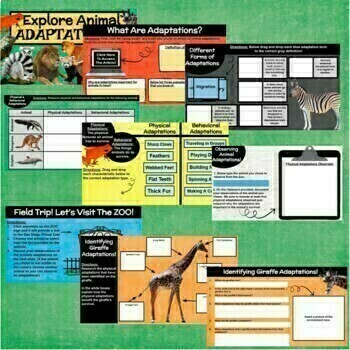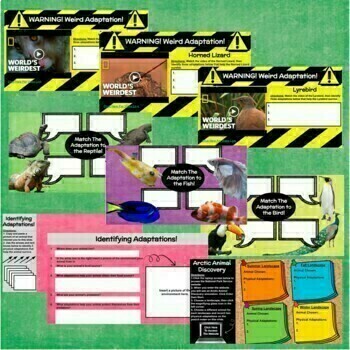Explore Animal Adaptations - Interactive Google Slides!
- Google Drive™ folder
- Internet Activities
- Webquests

What educators are saying
Description
Explore Animal Adaptations!
Students are given the opportunity to explore, identify, and match different adaptations to a wide variety of animals! A simulation, article, YouTube videos, etc. are all involved in these interactive slides!
- Students receive INSTANT feedback!
- 100% Digital! Product is created on Google Slides!
- NO Teacher Prep! Post directly to GOOGLE CLASSROOM!
- Great for Distance Learning!
- Answer Key Included!
Below is a break down of each slide!
Slide 1: Title Slide
Slide 2: Students are provided an article to read directly from PBS. The article discusses what adaptations are and why they are important for animals in all parts of the world. Students apply the article to three questions.
Slide 3: Students drag and drop different forms of adaptations to their definitions. Forms of adaptations include mimicry, defense mechanism, hibernation, migration, camouflage.
Slide 4: Students practice their knowledge on physical adaptations and behavioral adaptations by sorting different adaptation scenarios.
Slide 5: Students research physical and behavioral adaptations of three animals: anteater, kangaroo, and dolphin.
Slide 6: Students take a virtual field trip to the San Diego Zoo! Students watch a live feed of an animal they choose while observing their adaptations.
Slide 7: Students record five physical adaptations they observe from the animal they chose and describe why they are important for the animal's survival.
Slide 8: Students experience a weird adaptation as they watch a YouTube video from National Geographic's World's Weirdest on the Horned Lizard. Students record three adaptations of the Horned Lizard.
Slide 9: Students experience another weird adaptation as they watch a YouTube video from National Geographic's World's Weirdest on the Aye Aye. Students record three adaptations of the Aye Aye.
Slide 10: Students experience one last weird adaptation as they watch a YouTube video from National Geographic's World's Weirdest on the Lyrebird. Students record three adaptations of the Lyrebird.
Slide 11: Students match adaptation descriptions to four different birds. Birds include ostrich, tucan, penguin, and peacock.
Slide 12: Students match adaptation descriptions to four different reptiles. Reptiles include tortoise, alligator, rattlesnake, and iguana.
Slide 13: Students match adaptation descriptions to four different fish. Fish include blue tang, clownfish, betta fish, and cowfish.
Slide 14: Students are directed to National Park Service Website to an Artic Animal Discovery simulation. Students explore animal adaptations during four season landscapes.
Slide 15: Students identify six physical adaptations of a giraffe.
Slide 16: Students then answer specific questions regarding the giraffe's adaptations.
Slide 17: Students choose an animal they are interested in and identify five adaptations on the animal with provided arrows and text boxes.
Slide 18: Students then answer specific questions regarding the animal's adaptations.




